By Sumaiya Farheen and Andrew Siyabalawatte, Oct 2023.
A Balancing Act – Leg Length Discrepancy in Children and Adults
Leg Length Discrepancy (LLD) is a condition that affects many children and adults, often without them even realizing it. Whether your legs are slightly shorter or longer than the other, these differences can have a significant impact on your spine health.
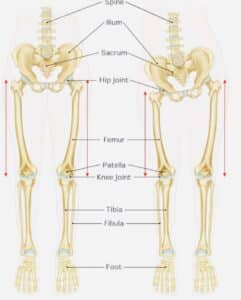
In this comprehensive guide, we will delve into LLD, examining how to measure it, and exploring the implications of a leg length discrepancy on your overall well-being.
The Effect Of A Shorter Leg Length Discrepancy
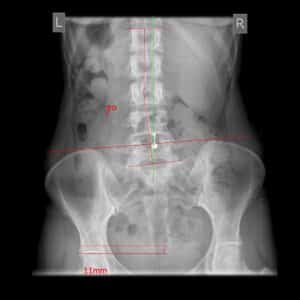
“Having a 5-10-mm or greater difference in leg length creates an asymmetry in the body that may cause lower back pain, hip pain and other problems”
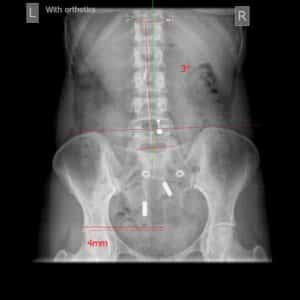
(Images above shows the xrays of our client’s posture correction, before and after, and with an insole)
A short leg is usually an indication of a structural or functional problem. This means, you may either have a leg that is actually shorter in length (structural) in other words, something you were born with, or the length of both legs only appears different because of problems elsewhere in the body (functional), an adaptation to postural imbalances.
This type of unevenness in the length of the legs not only affects your overall posture, but increases your chances of developing common health complaints such as low back pain and knee pain. A shorter leg length is also a common predisposition to the onset of hip arthritis.
Not sure if you have a shorter leg? get in touch with us just like our client in the image above did, and we will advise if you do, and what may work for you and your spine.
How to Measure Leg Length
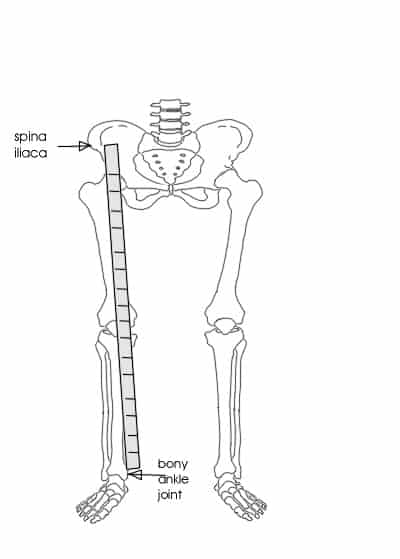
Measuring leg length discrepancy is essential to understand its impact and develop appropriate interventions. Healthcare providers employ a simple yet effective method to measure LLD.
To measure, you should lie down on the floor with your legs straight and your feet apart so they’re inline with your hips. Ask the second person to measure from directly under your hip bone to the bony joint on your ankle.
Write down the results in inches and repeat for the other leg. It’s worth noting that some difference in leg length is normal, so don’t be alarmed if one is longer than the other. However, if the difference is more than half an inch, it could be affecting the way you walk and the way your spine moves.
To ascertain the impact of a shorter leg on the pelvis and spine, healthcare providers take X-rays of the hip for a more precise measurement. This evaluation helps identify the root cause of the discrepancy and guides treatment decisions.
The Pros and Cons Of Short Legs vs Long Legs
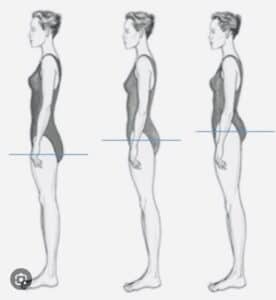
Short Legs
- Short legs mean less inertia, lower centre of gravity equals more stability.
- Faster pivots, better agility.
- Quicker off the mark, faster acceleration.
- Shorter legs are better for heavier weights.
Long Legs
- long legs offer longer stride lengths, more leverage.
- Endurance, built for long distance running.
- long legs create more stroke power.
- Jump higher, more efficiently.
Exercises For Leg Length Discrepancy After Hip Replacement
Leg length discrepancy is common following a hip replacement as the soft tissues surrounding the joint are stretched to the appropriate tightness to ensure that the joint stays in place. This functional change can result in a slightly longer leg length.
Certain exercises and stretches may help minimize the impact of leg length discrepancy following surgery and ease any related symptoms. Though care and attention needs to be given as to what exercises in order to prevent any complications following surgery. An insole or a lift in the shoe of the discrepant leg may be a better solution, as this functional adaptation can allow the hip and the rest of the body to adapt to it over time.
Conclusion
Leg Length Discrepancy is more common than one might think. As a result, the crucial step is to identify it early and take appropriate measures to ensure that your musculoskeletal health remains uncompromised. Furthermore, whether you have shorter or longer legs, rest assured that there are solutions available to help you maintain comfort and an active lifestyle.

